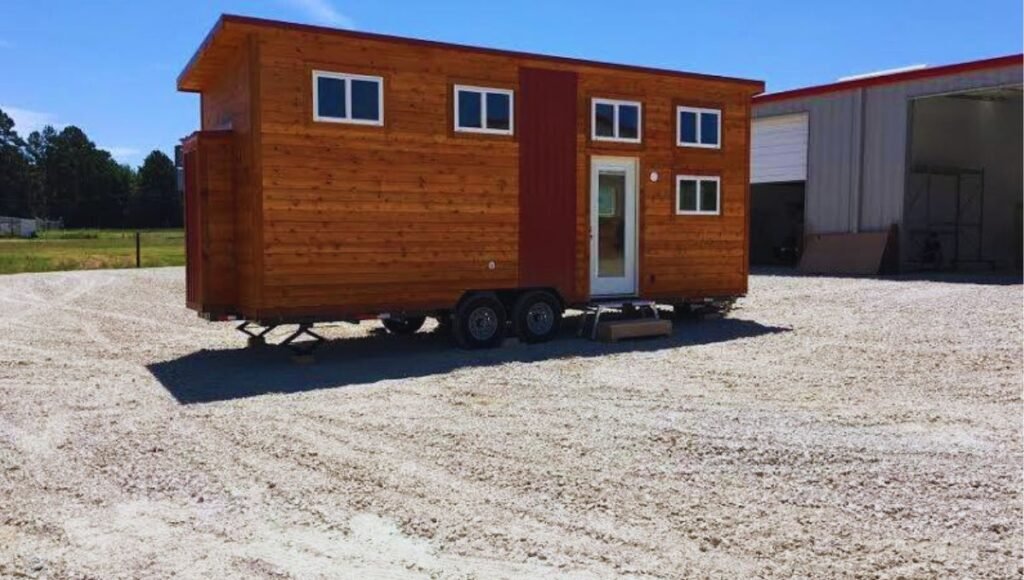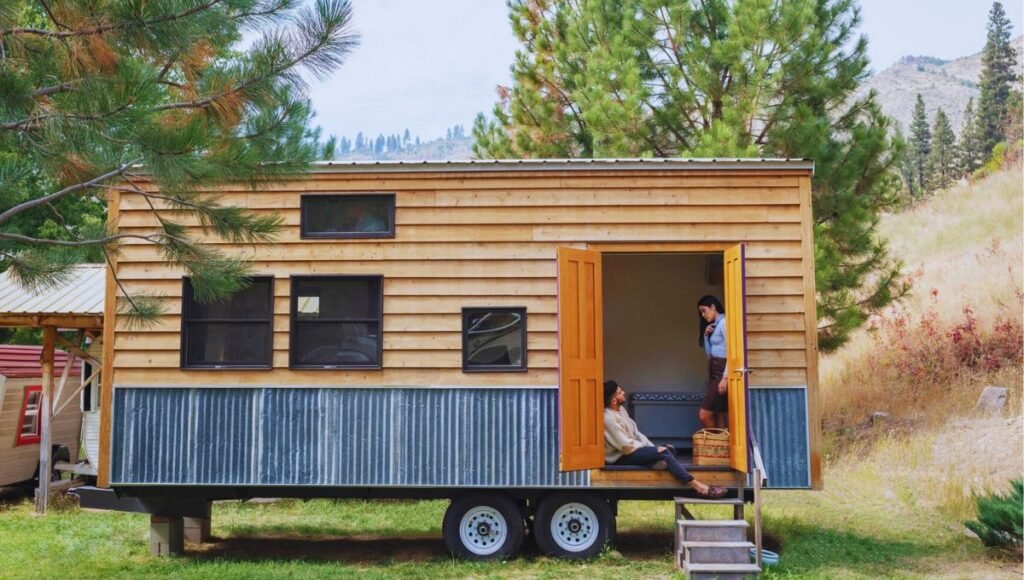Picture yourself standing on a plot of land, envisioning your dream tiny home nestled in a cozy Houston neighborhood. To make that vision a reality, you’ll need to navigate a maze of regulations. Zoning laws will dictate where you can place your tiny home, while building codes guarantee it’s up to safety standards. Don’t forget about utility connections, which are vital for everyday living. Property taxes and land use regulations also play a significant role. Understanding these key areas can help you avoid costly mistakes and legal challenges. So, what are the essential rules you need to know?
Key Takeaways
- Ensure compliance with Houston’s zoning laws, including setbacks, height limitations, and urban planning regulations.
- Use approved construction materials and build on a stable foundation that meets all building code requirements.
- Guarantee proper utility connections by consulting local providers and hiring licensed professionals for installations.
- Review and adhere to HOA guidelines for color schemes, materials, and design to avoid fines.
- Follow environmental sustainability requirements, including energy-efficient designs and eco-friendly materials.
Zoning Laws

In Houston, zoning laws play an important role in determining where tiny homes can be legally placed and inhabited. You’ll need to familiarize yourself with specific setbacks regulations, which mandate the minimum distance your tiny home must be from property lines, roads, and other structures. These rules ensure safety and proper urban planning.
Additionally, height limitations are essential; they dictate the maximum allowable height for your tiny home to prevent overcrowding and maintain neighborhood aesthetics. Understanding these zoning laws is necessary to avoid legal issues and ensure your tiny home complies with Houston’s regulatory framework.
Building Codes
Adhering to building codes is essential to guarantee that your tiny home meets all safety and structural standards set forth by Houston authorities. These regulations ensure that your construction is both safe and durable.
You should focus on the following key areas:
- Material Standards: Use approved materials that comply with Houston’s building codes to ensure longevity and safety.
- Foundation Requirements: Build a stable and secure foundation that meets the prescribed structural criteria.
- Safety Inspections: Schedule and pass mandatory safety inspections at various stages of construction to verify compliance.
- Fire Safety: Incorporate fire-resistant materials and ensure proper installation of smoke detectors and fire extinguishers.
Following these guidelines will help you create a safe and compliant tiny home in Houston.
Utility Connections
Once your tiny home meets all building codes, the next step involves guaranteeing proper utility connections to maintain functionality and comfort.
You’ll need to contact local utility providers to set up essential services, such as water, electricity, and gas. Confirm that the utility installation adheres to Houston’s regulations by hiring licensed professionals. These experts will handle the complex procedures, including trenching for underground lines and installing appropriate meters.
Additionally, verify that your tiny home’s infrastructure can support these connections, which might require upgrading certain components.

Don’t forget to schedule inspections with city officials to confirm compliance with safety standards. Proper utility connections are crucial for a seamless living experience, making it imperative to follow all procedural and regulatory requirements meticulously.
Property Taxes
Understanding how property taxes apply to your tiny home in Houston is essential for managing your long-term expenses effectively. The Harris County Appraisal District (HCAD) assesses property values to determine your tax obligations.
Here’s what you need to know:
- Assessment Methods: HCAD uses market value assessment, comparing similar properties to determine your tiny home’s worth.
- Tax Exemptions: You might qualify for exemptions such as homestead or senior citizen, reducing your taxable amount.
- Annual Review: Property values are reassessed annually, potentially altering your tax responsibilities each year.
- Appeals Process: If you believe your property assessment is inaccurate, you can appeal the valuation with HCAD.
Stay informed to make the most of possible savings while ensuring compliance.
Land Use Regulations
When considering tiny homes in Houston, you must adhere to zoning district requirements and meet minimum lot size regulations. These rules determine where you can place your tiny home and the smallest allowable parcel of land for your residence.
Understanding these regulations is essential for ensuring compliance and avoiding potential penalties.
Zoning District Requirements
Houston’s zoning district requirements dictate specific land use regulations that directly impact where tiny homes can be legally situated. Understanding these regulations is important for compliance and ideal site selection.
Key considerations include:
- Zoning District Classifications: Houston’s zoning laws categorize land into various classifications, such as residential, commercial, and industrial. Tiny homes are typically restricted to residential zones.
- Residential Zones: Within residential zones, there are further sub-classifications that may affect your tiny home placement. Confirm your tiny home aligns with the correct residential zone.
- Special Use Permits: Some areas might require special permits for tiny homes. Check if your intended location necessitates one.
- Compliance with Local Ordinances: Adhering to specific local ordinances is essential to avoid legal complications and ensure your tiny home is compliant.
Minimum Lot Size
Traversing Houston’s land use regulations, you’ll find that minimum lot size requirements play a pivotal role in determining where you can place your tiny home. The city’s regulations stipulate specific lot dimensions and accessibility standards to guarantee proper placement. Adhering to these guidelines is essential for legal compliance.
| Lot Size Category | Minimum Dimensions (sq ft) | Accessibility Requirements |
|---|---|---|
| Residential | 1,400 | Must have road access |
| Commercial | 2,500 | Proximity to public utilities |
| Mixed-Use | 1,800 | Easy access to main thoroughfares |
| Suburban | 2,000 | Adequate driveway and sidewalk |
Permits and Fees
Securing the necessary permits and understanding the associated fees are essential steps for anyone looking to establish a tiny home in Houston. The application process involves multiple stages, requiring detailed documentation and compliance with local regulations.
To streamline your journey, follow these steps:
- Submit Initial Application: Complete all required forms and provide architectural plans.
- Pay Initial Fees: Cover application and inspection fees, which vary by project size and complexity.
- Schedule Inspections: Coordinate with city officials for site and structural inspections.
- Permit Renewals: Make sure timely renewals to avoid penalties and maintain compliance.
Be meticulous during the application process and stay on top of permit renewals to keep your project on track and within legal boundaries.
HOA Restrictions
When considering tiny homes in Houston, you must be mindful of HOA restrictions that could impact your plans. Homeowners’ associations often enforce zoning and permit regulations, along with strict aesthetic requirements.
Reviewing these guidelines thoroughly is important to avoid potential conflicts.
Zoning and Permits
Understanding the zoning and permit requirements for tiny homes in Houston can be complex, particularly when considering the restrictive covenants imposed by Homeowners Associations (HOAs).
Temporary housing and parking rules often present significant challenges. HOAs may have specific guidelines that you must adhere to.
Here are key considerations:
- Zoning Laws: Confirm your tiny home complies with local zoning laws, which often dictate where you can place temporary housing.
- Permits: Acquire necessary permits before placing or constructing a tiny home.
- HOA Rules: Review HOA regulations that might restrict the placement and structure of tiny homes.
- Parking Regulations: Adhere to local parking rules, which may limit where you can park a tiny home if it’s on wheels.
Aesthetic Requirements
HOA restrictions on aesthetic requirements can greatly influence the design and appearance of your tiny home, necessitating strict adherence to community standards. You’ll need to verify that your exterior design aligns with the neighborhood’s established look. This often includes specific guidelines on acceptable color schemes, promoting uniformity and visual cohesion within the community.
It’s crucial to review your HOA’s covenants, conditions, and restrictions (CC&Rs) before finalizing any design plans. Non-compliance could result in fines or mandated alterations, which can be costly and time-consuming. Pay close attention to details, such as the types of materials allowed, roof styles, and even landscaping choices.
Conclusion
Understanding Houston’s tiny home regulations might appear challenging, but diligent dedication and detailed planning will lead to success. By having a thorough grasp of zoning laws, building codes, utility connections, property taxes, land use regulations, permits, and HOA restrictions, you’ll guarantee a smooth, stress-free process.
Don’t overlook sustainable design and community considerations—they are essential for compliance and community cohesion. With careful thought and commitment, your tiny home project will thrive in Houston’s housing landscape.